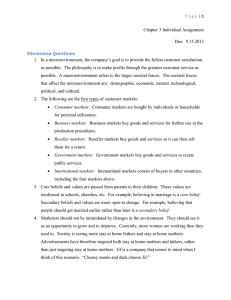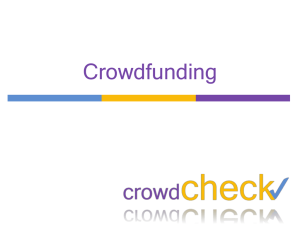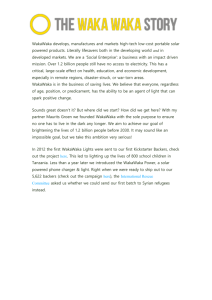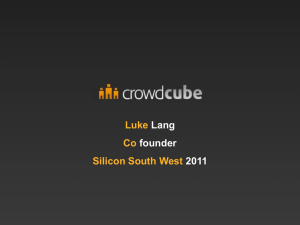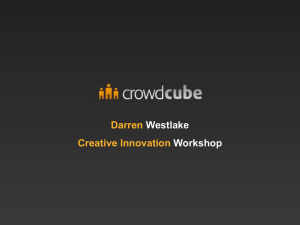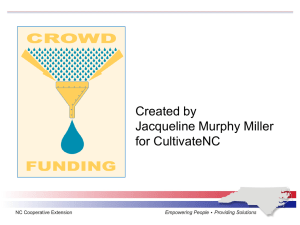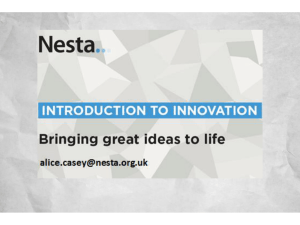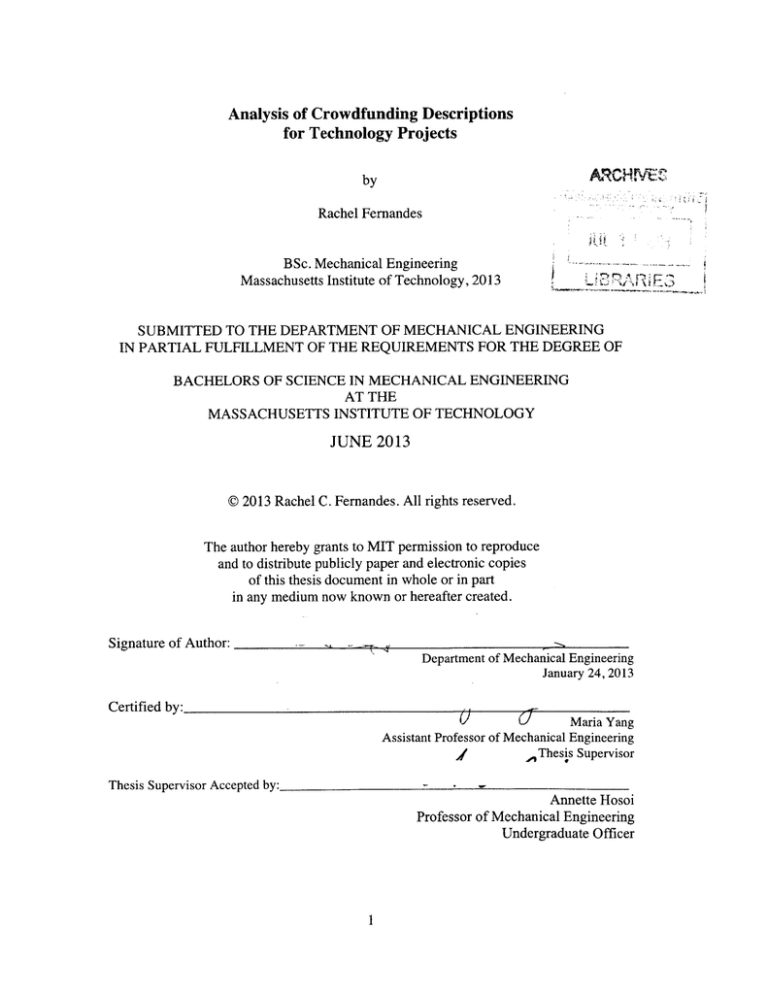
Analysis of Crowdfunding Descriptions
for Technology Projects
ARCHrVW'
by
Rachel Fernandes
BSc. Mechanical Engineering
Massachusetts Institute of Technology, 2013
:~j~x~
SUBMITTED TO THE DEPARTMENT OF MECHANICAL ENGINEERING
IN PARTIAL FULFILLMENT OF THE REQUIREMENTS FOR THE DEGREE OF
BACHELORS OF SCIENCE IN MECHANICAL ENGINEERING
AT THE
MASSACHUSETTS INSTITUTE OF TECHNOLOGY
JUNE 2013
C 2013 Rachel C. Fernandes. All rights reserved.
The author hereby grants to MIT permission to reproduce
and to distribute publicly paper and electronic copies
of this thesis document in whole or in part
in any medium now known or hereafter created.
Signature of Author:
-
,
Department of Mechanical Engineering
January 24, 2013
Certified by:
(U
Maria Yang
Assistant Professor of Mechanical Engineering
Thesis Supervisor
Thesis Supervisor Accepted by:
Annette Hosoi
Professor of Mechanical Engineering
Undergraduate Officer
1
J
Analysis of Crowdfunding Descriptions
for Technology Projects
by
Rachel Fernandes
Submitted to the Department of Mechanical Engineering
on May 23, 2013 in partial fulfillments of
a Bachelors of Science degree in
Mechanical Engineering
ABSTRACT
There are many factors that contribute to the success of a project on crowdfunding
sites, such as Kickstarter. These include, but are not limited to, the specified project goal
of funding, the success of similar projects, the funder incentives, the amount and type of
information given on project webpage, the credentials and trustworthiness of project
creators. Every successful project on Kickstarter has a project video, which introduces the
product.
This thesis analyzed four attributes of the project video to determine the success
of the project, i.e. whether or not the project received the requested funding. These
attributes included the trustworthiness of creators, level of demo of product, finish of
product and amount of excitement engendered by video. A survey of undergraduate
students was conducted, in which participants were asked to rank each of these attributes
for videos of both successful and unsuccessful projects. The results are discussed.
Thesis Supervisor: Maria Yang
Title: Assistant Professor of Mechanical Engineering and Engineering Systems
2
Acknowledgements
I would like to acknowledge, first and foremost, my supervisor for this Thesis,
Professor Maria Yang. She did everything in her power to work with me and support my
personal research interests and guided me through the development stages of this study.
She also did her utmost to accommodate my unfortunate health issues and was more
understanding than I could have wished for. I would also like to acknowledge the course
administrator, Brandy Baker, who opened her office doors to me, on multiple occasions,
when I was having difficulty choosing a thesis topic. Brandy also was invaluable in
helping me to accomplish this thesis despite my health problems. To both these women, I
am eternally grateful. I would also like to thank the participants in this study, who took
time out of their busy schedules.
3
1
INTRODUCTION
Crowdfunding has evolved with the Internet era to afford aspiring entrepreneurs
the opportunity to see their visions through. Anyone has the ability to post on sites, such
as Kickstarter, and ask for a respectable sum of money to fund his project. His success in
achieving his goal, however, depends, in part, on how well he pitches his idea and the
strength of the idea itself.
This study aims to understand crowdfunding and the variables that lead to
successful project funding through extensive review of the existing literature. It also aims
to add to this research area by analyzing how the project videos, the first features seen on
the projects' webpages, affect the outcome of the funding period, and thus how
successful the project is. Kickstarter suggests that each project produce a video five to six
minutes in length to present their idea/product. What is said, or how the product/idea is
presented, must have a strong impact on how the viewers/potential funders esteem the
product and the creator's potential to produce as promised.
The limitations of Venture Capitals and Angel Investors are discussed in the
Literature Review, as well as the natural evolution of crowdfunding. Since crowdfunding
is a somewhat recent development, it is expected that a limited amount of in-depth
analysis exists. But the studies found and described in the Literature Review suggest that
this area of research is now taking off as more and more people understand and
participate in crowdfunding.
Kickstarter is chosen as the subject of analysis. The site offers general statistics on
their successful and unsuccessful projects but most information is gathered from the few
studies that have been done that are Kickstarter-specific. A research gap is identified
from the sum of the literature that is reviewed, and this area is pursued in this study.
Only projects under the Technology category on Kickstarter are analyzed. Eight
projects are chosen, both successful and unsuccessful, and their videos are viewed by
survey participants, who rank specified qualities of the videos. Because of the
technological nature of the products being analyzed, some of the video qualities
suggested were also technical in nature. These qualities are then analyzed to see what
correlation, if any, exists between them and the success of the project, i.e. whether the
project receives its requested funding. If a correlation is identified, then this thesis simply
acts an indication of a trend that should be further studied to understand it in depth.
Therefore, this thesis simply unlocks an area of research to be pursued to better
understand the dynamics of crowdfunding, and what fuels people to give money to
strangers.
2
LITERATURE REVIEW
2.1 Understanding Crowdfunding From An Evolutionary Standpoint
Crowdfunding is the financing of a project or a venture by a group of individuals
instead of professional associations, such as banks, venture capitalists or angel investors.
In contrast, crowdfunding occurs without an intermediary, such as a bank: entrepreneurs
4
"tap the crowd" by raising the money directly from individuals. The typical mode of
communication is through the Internet [1].
Crowdfunding is a subset of crowdsourcing. Kleemann et al. (2008) defined
crowdsourcing as follows: "Crowdsourcing takes place when a profit oriented firm
outsources specific tasks essential for the making or sale of its product to the general
public (the crowd) in the form of an open call over the Internet, with the intention of
animating individuals to make a [voluntary] contribution to the firm's production process
for free or for significantly less than that contribution is worth to the firm" [2].
Lambert and Schwienbacher (2010) defined crowdfunding by extending this
definition of crowdsourcing to include particulars specific to crowdfunding: "an open
call, essentially through the Internet, for the provision of financial resources either in
form of donation or in exchange for some form of reward and/or voting rights in order to
support initiatives for specific purposes"[3].
The article "New Solutions to the funding Dilemma of Technology Startups"
discussed the evolution of how startups get funded from Venture Capital (VC) to Angel
funding to crowdfunding. It attempted to understand the shortcomings of each and
develop and improve on current crowdfunding practices to develop a new model that
addresses these issues. The study informs a large portion of the next five subsections [4].
It should be noted beforehand, that these shortcomings were used to inform the
methodology of this thesis by asking the question, does the move to crowdfunding via
websites such as Kickstarter actually eliminate the issues found with early methods of
startup investment? These shortcomings should be kept in mind when analyzing the
success of Kickstarter projects.
2.1.1
Shortcomings of Venture Capitalists
The study first discussed the issues with investing via venture capitalists. In this
climate, it has become difficult for venture capitalists to find companies to invest in. In
2010, the number of deals reached its lowest point since its steady decrease from 1997
[4]. Venture capitalist companies have been unsuccessful in adapting their business
accordingly and thus their value proposition to investors and entrepreneurs is being
markedly reduced.
Investors backing these companies have high expectations, but unfortunately the
firms cannot produce the expected return due to fewer and fewer promising startups. This
increased risk of illiquidity causes a shift in investor preference to other types of
alternative investment practices that provide a better risk/reward ratio. The case of a weak
venture capitalist proposition is similar for entrepreneurs as well. In the end startup
technologies need guidance and mentorship rather than large investments to get their
businesses going. Thus, venture capitalists will miss the mark, if they are only offering
improved financial offers [5].
2.1.2
VC to Angel Investors
These challenges with VC funding lead many entrepreneurs to turn to angel
investors, who, not only offer investment, but also offer greater attention and guidance to
the business [6]. Working with angel investors means acquiring venture capital from
5
individual investors. These individuals look for companies that exhibit high-growth
prospects, have a synergy with their own business or compete in an industry in which
they have succeeded. These potential companies, however, must be willing to share some
ownership and relinquish total control [7] .
Angel investors typically fill the gap between the original funding provided by the
founders, relatives, or small investors and later VC investment. In other words, they
usually finance startups up to $1 million [6]. Angel investors provide a more flexible
alternative to venture capitalists. They tend to require less information about the company
and it takes them less time to make an investment decision and they usually close a deal
within six weeks. As for the investment expectations, they usually require a 30-40%
return on investment, which is much less than what a VC firm expects.
Although angel investment looks attractive and more flexible, some due diligence
is necessary to make sure that they have the shoulders to support a startup during its
journey. The most common problems arises with abusive term sheets and agreements
signed between the entrepreneurs and the angel, cash shortage when the startup needs it
the most, and angels who have no prior experience of investing in startups [8].
2.1.3
Considerations for Technology startups
When it comes to technology entrepreneurs, it is important to nurture ideas that
could turn into successful ventures while keeping a strong customer focus. In order to
secure funding, entrepreneurs must understand the market in which they are competing
and be able to overcome the problems that may present themselves when creating a
successful venture. It is essential that they be able to create compelling business plans
with a strong focus on cash flow management and time to revenue, if they are to impress
investors assessing an investment opportunity [9]. According to the OED survey
conducted in 1998, over 70% of business plans are rejected because of a poor initial
impression of their financial merits and the abilities of the entrepreneurs to succeed [6]. It
is thus clear that many entrepreneurs would benefit from greater preparation when
looking for investment.
As such, further innovative solutions are required to help technology startups
overcome the funding challenges they encounter. Crowdfunding may be one such
solution. Crowdfunding calls the public to invest in ideas in the form of intellectual or
monetary support.
2.1.4
A move towards crowdfunding
Kickstarter is one such initiative and provides funding to projects that are related
to music, art, technology, film, food and other fields. The model it is based on is all-ornothing, that is, the invested funds are only released to the project's founders once a
critical threshold has been met. Otherwise, the funds are returned to investors.
2.1.5
What a better model might look like
The article "New Solutions to the funding Dilemma of Technology Startups"
discussed the basis of a new approach to startup funding, which used "the force of the
6
community (the crowd) to raise investments for startups and use an ecosystem (the
collective) to provide a robust startup selection, mentoring, and investment process". The
takeaways from the conclusions of the study, inasmuch as they inform the purposes of
this thesis, are summarized as follows:
* Creators of technology projects in particular need to be aware that, compared to
other types of investment, the crowd's decision-making is hampered by the
relative lack of information because startups need to keep strategic information
private at an early stage. Founders should note that if an investor does not have
this information at hand, he is more likely to make a poor investment decisions.
This affects how founders present themselves from the get-go. i.e. what is
conveyed up front.
* Investors should have some capacity to be active in the venture and provide
knowledge to build the business, but that their comments and ideas are
constructive are accepted only by the governance in place and community.
2.2
Funder Incentives And Trust-building In Crowdfunding
The study conducted by Belleflamme, Lambert and Schwienbacher (2011)
provides features of crowdfunding from an Industrial Organizational point of view based
on the results of a survey they conducted in 2010. For the purposes of this thesis, it
provided insight into funder incentives, and essentials of success, such as trust-building.
Crowdfunding can be viewed as a broader concept than purely fund-raising: it
provides insight into market potential by validating ideas in a specifically targeted
audience. One can get feedback on the product/service offered [10].
The investing crowd may be consumers and thus crowdfunders have an interest in
having the project realized not just for purely financial reasons. When investing crowd is
also acting as a consumer, "their pre-ordering enables price discrimination. The drawback
is that the extent to which the price-setting for both groups is optimal depends on the
financing needs for setting up production." If financing needs for setting up production is
large, the entrepreneur must encourage more consumers to pre-order which thus
constrains his ability to set different prices for contributing and non-contributing
consumers. Therefore, the right community needs to be identified such that the investing
crowd can enjoy "additional private benefit" [10].
Oestreicher-Singer and Sundararajan (2010) found that crowdfunders are
influenced by the success or failure of related projects and use the actions of other
crowdfunders as a source of information in their funding decisions [11].
Belleflamme et al conducted a survey and found that consumers who pre-order
are those with a high willingness to pay for the product. However these customers are
generally unidentifiable. Therefore community experience is important: project creators
should enhance the perceived quality of the product for the consumers who agree to preorder.
There is however a trade-off in crowdfunding. As crowdfunding offers an
enhanced experience to some consumers, it allows the firm to practice second-degree
price discrimination and obtain a larger share of the consumer surplus. However the firm
7
is constrained by the amount of capital that it needs to raise and thus larger amounts
require more consumers which in turn affects how profitable the menu pricing scheme is
[10].
The survey conducted by Belleflamme et al showed that trust-building is
essential. Crowdfunders are offered very little investor protection as most individuals
only invest tiny amounts leading to "corporate governance issues" [10]. In such cases,
crowdfunders have little right to protect their interests as stakeholders and are less likely
to intervene considering how small their contributions are anyway. It is thus paramount
that project creators build up their trustworthiness in whatever means possible.
In terms of further funding incentives, financial return seems to be of secondary
concern, suggesting that crowdfunders care about social reputation or enjoy private
benefits from participating in the success of the initiative. This was also shown to be the
case by Ghatak and Mueller, 2009 [12].
Belleflame et al stressed, however, that since the relationship between funders and
founders varies by context and the nature of the funding effort, it is difficult to come up
with an overall formula for success.
2.3
Further Determinants Of Success And Failure Of Crowdfunding
Projects
The study by Mollick (2012) drew on a dataset of nearly 47,000 projects with
combined funding of over $198M. It offered an initial description of the underlying
dynamics of success and failure among crowdfunded ventures [13]. Some of these
attributes include personal networks, underlying project quality and geography.
The aim of this study was to gain an analytical understanding of crowdfunding, by
using the extent of US-based projects on Kickstarter. They attempted to first understand
whether crowdfunding successes and failures are explainable, at least in part, by existing
theories on new venture performance; that is, does crowdfunding fit within the existing
literature on entrepreneurialism. "We do not know whether crowdfunding efforts
reinforce or contradict existing theories about how ventures raise capital and achieve
success" [13].
Therefore an in-depth analysis of when crowdfunding resulted in successful
product development was conducted, and the variables linked to success in crowdfunding
ventures were determined. Secondly they tried to understand what role, if any, geography
continues to play in new ventures in a crowdfunding regime, as crowdfunding websites
like Kickstarter essentially eliminate geographical constraints. They also try to
understand if crowdfunding "works:" that is whether or not crowdfunded projects
actually deliver results [13].
2.3.1
An educated guess at variables of success
They identified attributes of a project that could be predictors of success.
They measured project quality by the level of preparedness, which they considered
implied quality; this was determined by time and effort to ensure pitches were complete
and polished. It should be noted, that, to this end, Kickstarter usually suggests that
8
founders produce a video to demonstrate their level of preparedness:
videos succeed at a much higher rate than those without" [4].
"projects with
Mollick (2012) identified the following variables to determine their contributions
to project success:
- Project goal: The amount founders seek to raise using crowdfunding. While
many factors may influence project goal, there is a strong incentive for individuals to
select realistic project goals, since raising too little capital may result in project nondelivery, and high project goals likely make projects less likely to succeed.
- Funding level: The percentage of a project's goal actually raised by founders.
Projects that raise at least their goal are considered successful or funded projects.
- Backers: The number of funders supporting the project.
- Pledge: The amount of money raised divided by the number of backers, or the
mean pledge per backers.
- Facebook friends of founders: The role of social networks in funding new
ventures. Kickstarter is linked to Facebook; it was possible to determine how many
Facebook connections each founder has.
- Category: Kickstarter categories include Film, Dance, Art, Design and
Technology. This study acknowledged that Design and Technology projects were treated
somewhat differently by Kickstarter, since they usually delivered concrete products as
rewards. These projects needed to produce a manufacturing plan and a clear delivery date
for rewards.
- Updates: Founders on Kickstarter are encouraged to post updates about their
projects during and after the fundraising period. Updates represent efforts by founders to
reach out to current and potential funders, and to inform interested backers about
developments in a project. The data allowed them to track the content and timing of these
updates.
- Comments: Funders and potential funders can post comments about projects.
The data collected by this study on comments included details on the quantity and timing
of these postings.
- Duration:The number of days allotted to accept funding. Although Kickstarter
initially allowed projects to raise funds for as many as 90 days, it now limits this time to
60 days, but encourages 30 day funding windows.
2.3.2
Findings of Mollick (2012)
Mollick (2012) found that crowdfunding projects mostly succeeded by narrow
margins, or else failed by large amounts. It also seemed to be the case that projects that
signal a higher quality level are more likely to be funded, and large numbers of friends on
online social networks are similarly associated with success. According to their analyses,
there was a strong geographic component to the nature of projects, with founders
proposing projects that reflect the underlying cultural products of their geographic area
(such as country music in Nashville, Tennessee).
The data also suggested that "the nature of the population in which founders
operate is related to project success" [13]. Finally, the data showed that founders of
projects seemed to make efforts to fulfill their obligations to funders, though many
projects are delayed. They found that the size of the project predicted delays, with
9
overfunded projects being particularly vulnerable to delay, likely due to the increased
complexity and expectations associated with large projects.
Altogether, this study suggested that there is substantial value in further studying
the "dynamics of crowdfunding, since it sheds light on a variety of subjects of interest to
academics and policymakers, including the nature of funding for new ventures, the role
of individual quality and networks in venture success, and the importance of geography
in new ventures" [13].
2.4
Important Considerations For Crowdfunding Analyses
In crowdfunding, quality signals are further magnified through a Matthew Effect
which multiplies the impact of project quality [14]. This means that projects of esteemed
high quality attract backers who, in turn, promote them to potential backers, thus
increasing publicity and funding potential. Identifiable signals of project quality should
predict project success. Project quality may not be as clear or as influential to funders in
crowdfunding settings, compared with more traditional investments.
Mollick (2012) noted that it was important to consider that Kickstarter projects
cover a wide range of funding levels, so $100 projects may have to be modeled
differently from $100,000 projects.
2.5
Kickstarter-specific Information
Since Kickstarter was launched on April 28, 2009, over $600 million has been
pledged by more than 2.5 million people, funding more than 40,000 creative projects
[15]. In Kickstarter, an entrepreneur (called "creator" in Kickstarter) can create a
webpage for the project on the platform where they explain its purpose and what they
expect to deliver with the contributed funds. The creator indicates the funding goal of the
project (the amount of money they require to execute the project as specified), along with
an end date for the project funding cycle [14]. Table 1 shows a summary of Kickstarter
statistics for 2010-2011. Figure 1 shows a list of Categories available on Kickstarter as
well as the number of successful and unsuccessful projects as of May 2013.
10
Table 1:
Summary of Kickstarter Statistics for 2010-2011 [16]
Variable
Funded (1=yes)
Goal $)
Total Amount Pledged (S)
Percent of Goal Funded
Duration (days)
Total Number of Backers
Total Number of Backers in First Week
Total Number of Backers in Last Week
Number of Backers Added per Day
Average Contribution per Backer (5)
Number of Reward Categories
Maximum Reward Claimed 'S)
I las Video 'I=yes)
Number of Words in Title
Tide has Colon (1 =yes)
Number of Blog Posts by Kickarter
Number of Days on Top 50 Most Popular List
Total Number of Public Updates
Total Number of Private Updates Only to Backers
Proposed by a Serial Creator A1=yes)
Mean
Std. Dev.
Min
0.63
8509.83
4633.17
93.22
41.37
62.59
19.31
15.93
1.51
73.64
?.89
504.37
0.81
6.37
0.21
0.02
1.41
2.65
0.44
0.08
0.48
139093.10
13759.15
0
179.94
0
1
1
1
1
0
1
1
1
18.52
189.54
69.73
58.68
8.52
70.08
3.50
964.50
0.39
2.87
0.40
0.15
4.96
4.09
1.28
0.26
1
1
0
1
0
0
0
0
0
0
Max
1
21474836
942578
15454.20
93
13364
4683
3535
2212
1679.67
31
100(v
1
19
1
4
75
83
49
1
Creators can communicate with their supporters and/or potential contributors by
posting private or public updates. When a potential donor (called "backer" in Kickstarter)
visits an active project's webpage, they are presented with all the project information
initially posted by the creator. Moreover, potential backers are shown the current funding
status of the project (i.e., the funds raised thus far), the ultimate funding goal, and the
number of days remaining until the project funding cycle expires directly adjacent to the
project video.
A visitor can also see a listing of the other backers that have contributed to the
project, as well as the timing of these contributions. Individual donations are not publicly
shown. Kickstarter has a number of search options to help potential backers discover
projects they want to support. In particular, projects can be sorted based on the first week
after their initial launch (Recently Launched), last week before the project funding closes
(Ending Soon), or popularity (based on the number of backers recently added to a
project) [16].
11
30,000
25,000
20,000
15,000
10,000
--5,000
-~
-
-
U
b,
C7
(,O~
41
V
A3
' Unsuccessfully funded
Successfully funded
Figure 1: Successful and Unsuccessful Projects by Category [15]
3
RESEARCH GAP
Recent research, such as the studies described in the above Literature Review,
take promising strides in better understanding the value of crowdfunding through sites
such as Kickstarter, as well as the variables that could possibly affect whether or not
these projects get the funding they ask for.
These variables include funder incentives, the level of trust developed between
funder and founder, geography, project category (like Music, Technology, Film etc.) and
underlying project quality. The work presented in this paper seeks to further add to this
area of research by considering how project videos affect the success of the projects, in
terms of funding achieved. The extent to which the videos impact success of the project
has been minimally studied, such that only the existence of the video vs. the success of
the project was documented. This thesis aims to analyze aspects of the video and
determine for each whether there could be a possible correlation with project success.
12
4
METHODS
4.1
Determination Of Success Variable From Literature Review
The literature review discussed the shortcomings, model analysis and success and
failure analysis of crowdfunding. This extensive literature review directly informed the
focus of this thesis, through what was suggested would contribute to the success of a
crowdfunding project. The following potential variables of success summarize and build
on the takeaways of the existing work:
* Amount and type of Information of Invention
* Kickstarter category (i.e. Film, Technology, etc.)
* Rewards (Funder Incentives)
-
Type of reward
-
If pre-ordering is available, the percentage of funders who pre-order.
This won't hold if pre-ordering is the only option.
* Trustworthiness of creators
-
Credentials
Tone of video
Quality of updates
Frequency of updates
Do they give a progress-report?
* Duration of project funding
* Video
*
*
-
Do they have one?
-
To what extent do they demonstrate the product?
What is the level of finish of the product?
-
How engaging is the video?
Success or failure of related projects
Quality of manufacturing plan
Project videos were selected as the success variable to be analyzed. Each project
video was broken up into its relevant attributes/characteristics, later referred to as Xi.
Four attributes were chosen based on what was assumed could be reasonably determined
and judged upon a viewing of the video of a project, without consideration of the
information available elsewhere on the project webpage, such as Manufacturing Plan,
creator credentials and so on.
4.2
Chosen Kickstarter Projects
The projects were constrained to the Technology domain, to enable specific
questions to be addressed. They were also chosen to be within a project goal range, ie.
$30,000 to $500,000. The videos of eight projects, were chosen to be analyzed: four
successfully funded projects, and four unsuccessful projects. It should be noted that
13
success was defined by whether or not the project reached its project goal in the allotted
funding time, and represented by a 'success coefficient' defined later. The successful
projects are shown in Figures 2a-d and the unsuccessful are shown in Figures 3a-d.
ARCTIC
WHITE
JET
BLACK
CHERRY
RED
(a) RigidBot 3D Printer
(b) Pebble e-Paper Watch for iPhone and
Andriod
(c) Smart Herb Garden
(d) 3Doodler
Figures 2(a-d): Successfully funded projects
(a)
(b)
(c)
(d)
[source:
[source:
[source:
[source:
http://www.kickstarter.com/projects/1650950769/igidbot-3d-printer?ref=live]
http://www.kickstarter.com/projects/597507018/pebble-e-paper-watch]
http://www.kickstarter.com/projects/mattiaslepp/smart-herb-garden]
http://www.kickstarter.com/projects/1351910088/3doodler]
14
(a) HubDock Bicycle Wheel Quick Release
(c) EZ3D Desktop Printer
(b) Suntrunks- Solar Power to go
(d) Instaprint
Figures 3(a-d): Unsuccessfully funded projects
(a)
(b)
(c)
(d)
4.3
[source:
[source:
[source:
[source:
http://www.kickstarter.com/projects/486778887/hubdock]
http://www.kickstarter.com/projects/670631330/suntrunks]
http://www.kickstarter.com/projects/jakewood/the-ez3d-desktop-printer]
http://www.kickstarter.com/projects/breakfastny/instaprintl
Survey to Analyze Project Videos
A survey of twelve undergraduate students was conducted to determine how
video viewers would rate each of the eight videos with respect to the attributes specified.
Table 2 identifies this list of video attributes and quantifies the ranking used in the
survey. A Comments section was also added for each video that encouraged participants
to list their reasons for their rankings or suggest other features that could contribute to the
success of the videos.
The survey participants covered a range of technological and non-technological
majors, including Bio-Engineering, Political Science, Literature and Mechanical
Engineering. Although Mechanical Engineers, for example, may be more qualified to
15
answer technical questions, such as "How far along a product is in its prototyping
stage?", the range of majors was chosen to more accurately represent the range of backers
who would view Technology projects on Kickstarter [15].
Each participant was surveyed individually so as to avoid group persuasion. The
videos were set up by the surveyor on full screen, such that the rest of the project
webpage was non-viewable. This ensured that the participants were unaware of which
project was successfully funded or not. At the top of each survey sheet, participants were
asked to note that their opinions of the product itself should not have biased their
judgment of the videos, and thus should not have affected the way in which they
answered the questions.
Table 2:
Survey questions that asked to rank various video attributes
Trustworthiness
How would you rank the trustworthiness
of the creators in the video?
ie. How much would you want to invest in
these people; do you trust them to produce
5. Seem very
as promised?
trustworthy
Product Finish
In your opinion, what is the level of finish
of the product depicted?
Demo
How well is the product demonstrated in a
real situation?
1. Sketch/Concept
2. Technical Drawing
3. 3D model/ CAD
model
4. Physical
representation
5. Looks like a useable
product
1. Not at all
Excitement
Level
How excited/captivated are you by this
video?
1. Seem unreliable
5. Can be in stores now
1. Unmoved
5. Very excited
4.4
Tools Of Analysis
Information was gathered on each of the products, including the project goal (how
much money they are asking for), funds raised, number of backers. From these values the
average pledge for each project was determined. A "success coefficient", I, was also
determined for each project such that,
_ Funds received
Funds requested
These values are summarized in Tables 3(a, b).
16
Spearman Correlation [17,18]
Spearman's correlation coefficient, p, was used to measure the strength of
association between the two ranked variables. These variables were the average rating of
each video attribute, X1 , and the 'success coefficient' of each video, 'Pa,
where i - video attribute (four in total)
j - video (eight in total).
The average ratings of each video attribute per video are summarized in Tables 4(a,b).
4.4.1
To determine p, the di2 term must be found. This was done tabularly, for the Ith
attribute, via the following steps:
1. The data was sorted by 'P in the first column. The second column was added and
assigned as Vj, the ranked values (1,2,3,...8) in ascending order of 'j.
2. Next, the data was sorted by the now third column, X1 . A forth column, xj, was
created and similarly assigned ranked values (1,2,3,...8).
3. A fifth column, di, was created that held the differences between the two rank
columns (ij and xj). The sixth column holds the value of di2.
The Spearman Coefficient, p, was then determined for each attribute via the following
formula:
62
2
n(n
_ 1)
where n= number of videos (eight).
Plots of X3 vs. 'P were made for each attribute and labeled with the corresponding
p value. A log scale was used on the x-axis. See Figures 4(a-d) for these plots. Spearman
Correlation was thus used to determine the strength of correlation between video attribute
and success of project.
The closer the Spearman Correlation was to either +1 or -1, the stronger was the
correlation between the video attribute and the 'success coefficient' of the video, i.e. the
success of the project.
e
.00-.19 "very weak"
0 .20-.39 "weak"
e
.40-.59 "moderate"
e
.60-.79 "strong"
e
.80-1.0 "very strong"
The fit of the data points on each plot should be as close to monotonic increasing or
monotonic decreasing as possible, to represent a strong correlation.
17
5
5.1
RESULTS
Statistics Of Chosen Projects
Table 3a:
Statistics of successfully funded nroiects
3Doodler
Smart Herb
$30,000
$75,000
$2,344,134
$625,851
26,457
10,477
$88.60
$59.74
78.1
8.34
$100,000
$31,500
$10,266,845
$1,902,098
69,929
1,952
$146.82
$974.44
102.7
60.4
Garden
Pebble Watch
RigidBot 3D
Printer
Table 3b: Statistics of unsuccessful projects
Instaprint
Suntrunks- Solar
Power to go
EZ3D Desktop
Printer
HubDock Bicycle
Quick Release
$500,000
$36,900
$222,177
$3,255
862
27
$257.75
$120.56
0.444
0.088
$25,000
$11,759
39
$301.51
0.470
$47,000
$6,510
57
$114.21
0.139
I
Rear Wheel
5.2
Summarized Survey Results
Table 4a: Survey results for successful projects: Average rank per attribute per video
3Doodler
Trustworthiness
Product Finish
4.67
4.50
Smart Herb
Garden
4.50
4.75
Demo
Excitement Level
4.42
4.00
4.67
4.67
18
Pebble Watch
4.50
4.83
RigidBot 3D
Printer
4.42
4.08
4.83
4.83
4.58
4.33
Table 4b: Survey results for unsuccessful
-irustwortniness
Product Finish
Demo
Excitement Level
5.3
rank ver attribute ver video
13.83
4.08
3.25
1.75
4.17
3.83
3.92
3.92
13.83
3.42
1.17
2.42
4.17
4.17
4.08
2.58
Spearman Correlation Calculations
Table 5a: S-earman Calculations for 'Trustworthiness'
0.088
0.47
0.138
0.444
1
4
2
3
.3.83
3.83
4.17
4.17
1
2
3
4
0
2
-1
-1
0
4
-1
1
60.4
8.3
102.6
78.1
6
5
8
7
4.42
4.5
4.5
4.67
5
6
7
8
1
-1
1
-1
1
1
1
1
Table 5b: Spearman Calculations for 'Product Finish'
0.47
0.444
0.088
60.4
0.138
4
3
1
6
2
3.42
3.83
4.08
4.08
4.17
1
2
3
4
5
3
1
-2
2
-3
9
1
4
4
9
78.1
8.3
102.6
7
5
8
4.5
4.75
4.83
6
7
8
1
-2
0
1
4
0
19
Table 5c: Spearman Calculations for 'Demo'
0.47
0.088
0.444
0.138
4
1
3
2
1.17
3.25
3.92
4.08
78.1
60.4
8.3
102.6
7
6
5
8
4.42
4.58
4.67
4.83
1
3
9
2
-1
1
3
4
0
-2
0
4
5
6
7
8
2
0
-2
0
4
0
4
0
Table 5d: Spearman Calculations for 'Excitement Level'
0.088
0.47
0.138
0.444
1
4
2
3
1.75
2.42
2.58
3.92
1
2
3
4
0
2
-1
-1
0
4
1
1
78.1
60.4
8.3
102.6
7
6
5
8
4
4.33
4.67
4.83
5
6
7
8
2
0
-2
0
4
0
4
0
5.4
Spearman Correlation Results For Each Video Attribute
Table 6: S earman Correlation of each attribute in descending order
Trustworthiness
Excitement Level
Demo
Product Finish
0.881
0.833
0.738
0.619
20
Spearman Correlation = 0.619
Spearman Correlation =0.738
Xi
Xj
4-
-2-
3.5
3-
-2
-1
0 T
1
2
-2
3
(a) Demo
5
4
3
qI'1
2
3
(b) Product Finish
Spearman Correlation = 0.833
ii
-1
1~
Spearman Correlation= 0.88
x5
-
4.5
*
---
-
V
3.5
2
3
1
-2
-1
0 W
1
(c) Excitement Level
2
S-2
3
-1
-
1
2
(d) Trustworthiness
Figures 4(a-d): Plots of Spearman Correlation for each video attribute
According to the Spearman correlations obtained, there seems to be a 'strong' to
'very strong' correlation between video attributes and success of the projects. The
seeming trustworthiness of the projects' creators, as presented in their videos, seems to
have a particularly strong correlation with how much the projects get funded. It also
seems to be important how exciting the videos themselves are.
5.5
Survey Comments
There were more comments, in general, for the unsuccessful projects. Participants,
in other words, were more likely to leave negative comments than positive ones.
However for a couple videos of the successful projects, participants noticed that the
advertised products were second models of existing products, invented by the project
creators. The comments showed one place of issue with the successful videos. Namely, it
was mentioned by two participants that the Smart Herb Garden video used sketches to
demonstrate its uses, although there was an existing working (sellable) product.
Participants suggested that this could be misleading as to the finish of the product. The
Pebble Watch was praised as having exceeding amounts of demo.
21
The comments on videos of the unsuccessful projects were as follows. The
creators of Instaprint seemed like "hippies", and thus could become uncommitted to
carrying through on their project. The project was unsuccessful although it too, like many
of the successful projects, was an improvement of an existing product.
The video for Suntrunks had the most comments. In general, participants
commented on the video's poor quality. Although the product itself was shown, how it
worked was not actually demonstrated: the creator gave hypothetical instances of use.
The video looked like it was "made in the 90s", and the creator's style of presentation
was lacking, as he talked throughout the entire video, as if he were giving a presentation.
Indeed the business case was presented "in PowerPoint style" and there was too much
information and thus "very boring".
The video for the EZ3D Desktop Printer also seemed to give too much
information all at once. The quality of the video style was poor and seemed to be a "first
draft". The creators talked about their incentives and the possible production problems
that were likely, but did not demonstrate how their product actually worked. They
mentioned that it was demonstrated in additional videos throughout the webpage, but
according to a couple survey participants, viewers had no interest in following up.
For the HubDock video, the general consensus was that everything was fine,
except the narrator sounded like he was "falling asleep" and thus led to the video being
unexciting.
6
CONCLUSIONS
There seems to be a definite correlation between particular qualities of a project's
video and the success of the crowdfunding project, in the Technology domain. In
particular, the more exciting a project video is, and the more trustworthy the project
creators appear to the viewers, the higher the success rate of the projects.
The survey conducted for this study was not the most extensive considering the
constraints of this specific project: as each participant was required to watch eight videos
and answer eight sets of questions, it was obviously difficult to find willing participants.
Furthermore, all the participants were MIT undergraduates, who may have a baseline
understanding of product design, prototyping etc. This pool may not directly represent the
average Kickstarter user browsing the Technology projects on the site.
With Technology projects in particular, it was evident via analysis, that project
creators have to make tradeoffs, with respect to how much technical information they
should give without overloading or boring their potential funders and also how dazzling
they can make their pitch, without undermining the quality of their project. Thus potential
entrepreneurs in Technology could have a hard time on crowdfunding sites if they do not
understand that this balance must exist. At the same time, this potential problem is a good
justification for why this area of research warrants some attention.
22
7
FUTURE WORK
Future work should expand this area of research to incorporate more than just
Technology projects. It should also take into account further aspects, such as 'Opening
Pitch', 'Level of Information Given', 'Clarity of Explanations' and 'Tone of Video'. This
work should attempt to maintain other variables, as discussed in this thesis, as controls to
optimize the accuracy of the results. The work presented here only scratches the surface
of what is left to be discovered, on the road to determining what contributes to the
success of crowdfunding projects.
23
8
BIBLIOGRAPHY
[1] Schwienbacher, A. Larralde, B. 2010. Crowdfunding of Small Entrepreneurial
Ventures: Oxford University Press.
[2] Kleemann, Frank, G. Gunter Voss and Kerstin Rieder. 2008. "Un(der)paid
Innovators: The Commercial Utilization of Consumer Work
through
Crowdsourcing." Science, Technology & Innovation Studies 4:1, 5-26.
[3] Lambert, Thomas, and Armin Schwienbacher. 2010. "An Empirical Analysis of
Crowdfunding". Available at SSRN: http://ssrn.com/abstract=1578175.
[4] Kousari, A. "New Solutions to the Funding Dilemma of Technology Startups".
Technology Innovation Management Review. n.p. June 2011.
[5] Galbooni, J. Rouzies, D. 2010. "The VC Shakeout." Harvard Business Review. Web.
July 2010.
[6] Liu, Y. 2000. An Overview of Angel Investors in Canada. MFA, University of Texas.
[7] "A Guide to Angel Investors" EntrepreneurMagazine. Entrepreneur Media Inc. n.d.
Web. 01 April 2013.
[8] Zwilling, M. 2011. "Learn to Do the Right Thing For Your Startup." Forbes
Magazine. Web. 17 May 2011.
[9] Wehrum, K. 2009. "Get your wings". Inc. Magazine. Web. 09 Jan 2009.
[10] Belleflamme, P. Lambert, T. Schwienbacher, A. 2011. Crowdfunding: Tapping the
Right Crowd. CORE Discussion Paper No. 2011/32. Available at SSRN:
http://ssrn.com/abstract=1578175.
[11] Oestreicher-Singer, G. Sundararajan, A. 2010 The Visible Hand of Peer Networks in
Electronic Markets. Mimeo.
[12] Ghatak, M. Mueller, H. 2009. Thanks for Nothing Not-for-Profits and Motivated
Agents. LSE STICERD Research Paper Nbr. EOPP 014.
[13] Mollick, E. 2012. The Dynamics of Crowdfunding: Determinants of Success and
Failure: The Wharton School of the University of Pennsylvania.
[14] Merton, R. (1957). Priorities in scientific discovery: a chapter in the sociology of
science. American sociologicalreview.
[15] Kickstarter.n.p. n.d. Web. May 14, 2013. <http://www.kickstarter.com/help/stats>.
[16] Kuppuswamy, V. Bayus, B. 2013. "Crowdfunding Creative Ideas: The Dynamics of
Project Backers in Kickstarter".
[17] "Spearman Rank Correlation Coefficient." Wikipedia. n.d. n.p. May 18, 2013.
[18] "Spearman's Correlation".Statstutor.ac.uk. n.d., n.p. May 19, 2013.
24

